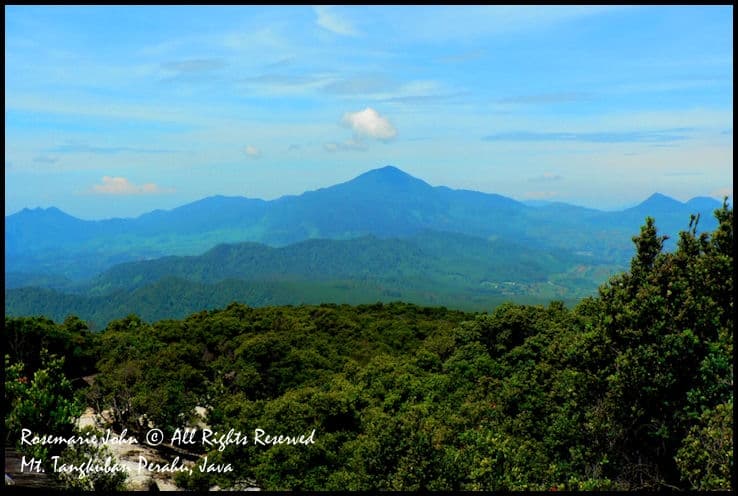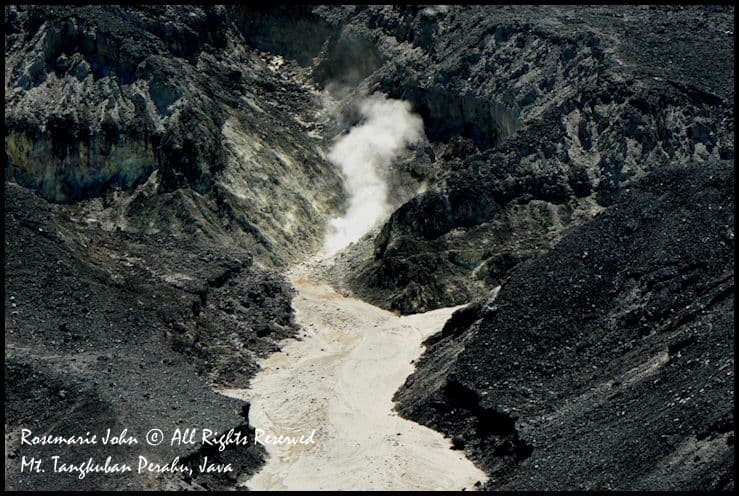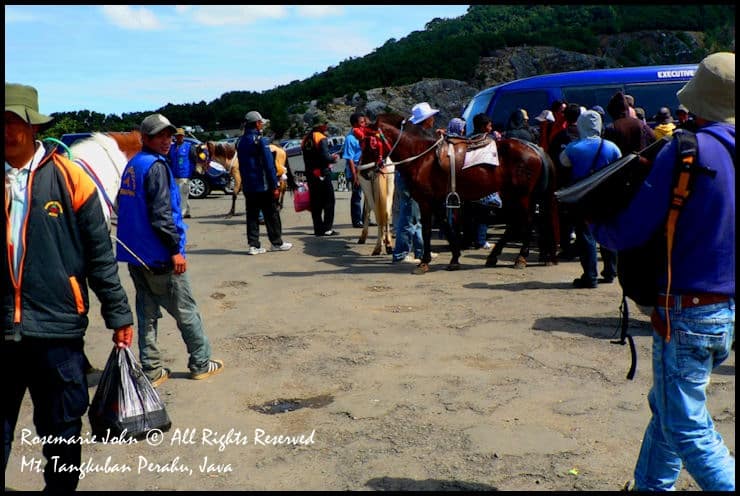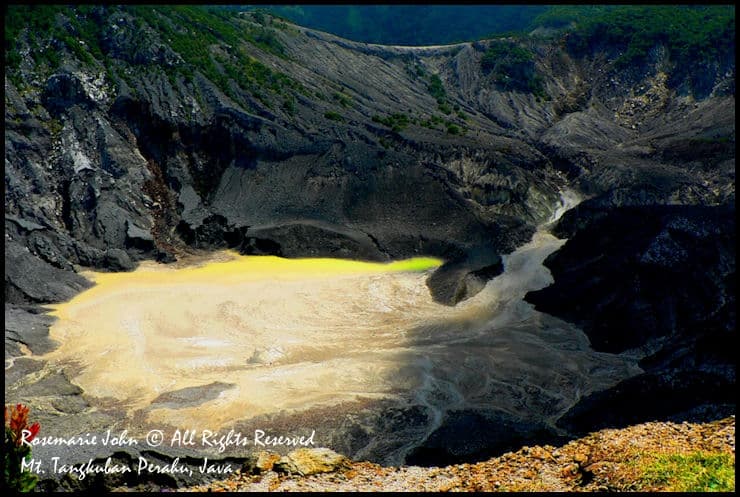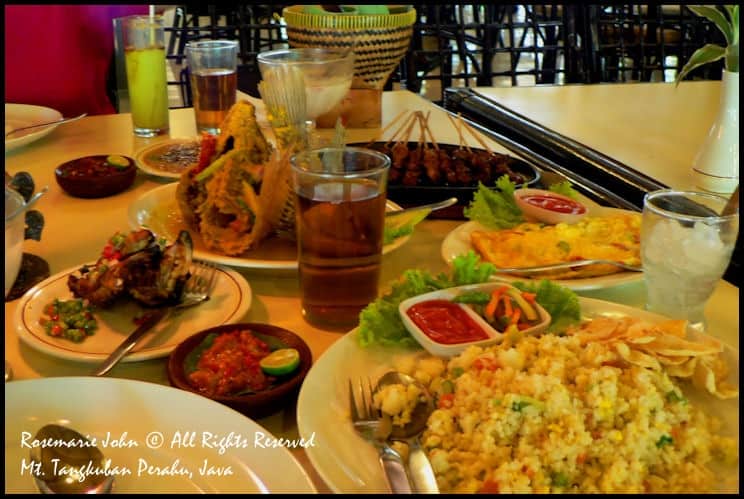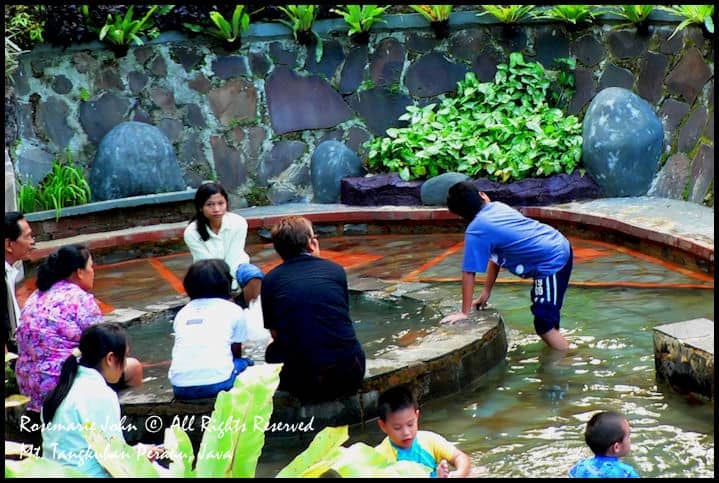Along misty mountain landscape and lush green tea plantations of Bandung lies the fabled crater of Mt. Tangkuban Perahu, the only ‘drive-up’ volcano on the island of Java, West Indonesia. The three-hour drive from Jakarta to the craters edge takes you through long winding pebbly roads, dense shrub, enthusiastic hikers, toiling farmers and occasional cars. But just when you thought you were lost on the serpentine road, the crater reveals itself in all its splendour.
It was born a hundred thousand years ago and at 2,084 meters high Tangkuban Perahu is an active stratovolcano which has a twin crater (Kawah Ratu and Kawah Upas) at the summit. It is located thirty kilometres north of Bandung, a sleepy city that is situated 768 meters above sea level.
Do not be fooled by its quiet demeanour, it is very much active though it has not vented its fury lately. It is widely believed that between 2000 to 6000 years ago multiple eruptions took place in Tangkuban Perahu and the lava, mud, rock and ash it spewed blocked the Pedalarang valley. The eruptions blocked the course of the Citarum River and the Bandung basin filled to form a lake sprawling approximately 700 square kilometres. Of late, the lake seems to have mysteriously drained away causing a great ongoing debate among geologists.
One can travel to this mystical mountain by hiring a car, a taxi, through various tour operators and groups or simply hiking up the mountain trail if you are up to it. The easiest and most comfortable option would be to hire a car and driver and explore the mountain on your own time instead of being pressed for time that has been allocated to say a tour group. It is best to ensure that your guide or driver knows his way around the roads and tourist spots of Bandung before setting out on this trip.
Journey On
Say you decide to embark on this trip at the break of dawn, nestled in the comfort of your car seat with a hot cup of Javanese coffee, the view outside is truly idyllic as your drive leads you past sleepy mist covered villages along the Lembang plains. The road enters an enchanted pine forest and two kilometres after that: right on the crest is a marked turnoff to the left; you are now on the road that leads you to the top of the volcano.
The entry gate about five kilometres below the summit opens at 6.15am and closes at 5pm. Your drive leads you to a toll gate for which an entrance fee for each person has to be paid. This rate is not a fixed one and with a little negotiation, it can be reduced.
Deep in the shadows of these ancient crater walls, farmers till the land. The fertile land in the deep gorges yields a great variety of vegetables like potatoes, cabbages, carrots, broccoli and leeks. A great many fruit and vegetable vendors can be found at the foot of the mountain selling their fresh produce at unbelievably low prices.
Past fruit and vegetable fields your road is turning and twisting. The road is lonely and quiet; it almost seems desolate, parts of it washed away to a rocky waste by the rains. It suddenly seems far and just when you wonder how long it’s going to take, you are on the top.
As you get down with wobbly knees and a bit groggy depending on which route you took up the crater you are either greeted with a swarm of dragonflies or foggy mountain mist. Again this is depending on what time of the day you choose to make your visit.
You are also greeted with local tourists and a bunch of English-speaking touts who will try to sell you anything from volcanic rock to China made curios. But this distraction pales into insignificance compared to the overwhelming presence of the star attraction – Mt. Tangkuban Perahu.
You are now atop an upside down boat-shaped mountain. It is a shape that inspired its name and a legend. ‘Tangkuban’ means upside down and ‘Perahu’ means boat. A cool strong mountain breeze with a whiff of sulphur hits you. Your nose tingles in the cold breeze. Your senses come alive. A strange peace engulfs you.
Up here on this isolated mountain, urban civilizations seem to just melt away. You seem to be transported into some distant past. You feel you are among the people of the old and their legend.
Mystical Mists
In the days of ancients, say the local folk lived a young man named Sangkuriang who was a powerful lad with mystical powers, a wanderer who fell in love. It is a tale of forbidden love.
In the mighty land of Sunda lived a princess, her name was Dayang Sumbi. She was beautiful, she was clever, she was pampered and so she was spoilt. Due to some extraordinary circumstances she married a dog named Tumang, a demigod possessing magical powers. Soon she gave birth to a son whom she named Sangkuriang.
The boy was separated from his mother but was guarded by his dog. He never knew that the faithful dog that followed him where ever he went was his own father. He only thought of it as his loyal companion. One day while hunting, he accidentally killed his dog and never knew the truth of his birth.
He wandered across the lands of Sunda from village to village trying to figure out his roots. If he could only find his parents his destiny would be complete. But destiny had different plans for young Sangkuriang. Meanwhile Dayang Sumbi was in great sadness for the loss of her son. The gods empathized with her situation and granted her the power of eternal youth so that she could find her son someday.
Sometime during the course of his wanderings Sangkuriang met a beautiful woman with whom he deeply fell in love. He neither realized that the village he wandered into was his homeland nor the woman he fell in love with was his own mother. They planned to get married soon. One day while stroking the hair of her beloved, Dayang Sumbi discovered to her horror that he was actually her long-lost son.
Not wanting to break this unbearable truth to him she unsuccessfully tried to dissuade him. Desperate to avoid marriage she set forth conditions she thought were impossible for him to meet. Sangkuriang was to build a lake in the valley and then build a boat for the couple to sail in after they were married. This task was to be accomplished in a day before daybreak.
Young Sangkuriang set about his task in earnest. Using his extraordinary powers he summoned mythical giants to build a dam and a boat. They worked all night. Just when they were almost done, Dayang Sumbi summoned the Gods and made the sun rise much earlier than usual upon discovering that Sangkuriang would accomplish his task before dawn. Sangkuriang’s herculean effort was a failure.
When he realized that he was deceived Sangkuriang in a fit of fury kicked the half finished boat down the valley back into the forest. There it lies today upside down, forming the mountain Tangkuban Perahu. The couple drowned themselves in the lake. This is a tale passed from generation to generation until today.
Reality Check
As you look down the crater that is now slowly getting engulfed in mist brought by the winds from yonder, you actually begin to ponder if the legend was true after all. The area has a mystical ambience and serves as a perfect backdrop to make myths come alive in your fertile mind. But alas! Your reverie is soon broken.
Those vendors are a persistent lot and if they still haven’t convinced you to buy a stone they will probably be telling you their own versions of the legends surrounding the volcano or may offer to take you down to an even more beautiful volcano on the other side.
But you would tend to brush them aside as minor irritants because now standing at the edge of the crater, your attention draws you to the bed of the crater where you see thick smoke and gas still emanating. You are looking at the “Queen Crater” called Kawah Ratu.
A twenty-minute walk around its rim allows you to view the still active secondary crater, Kawah Upas. It is steep and slippery in most parts, hence exercise caution. Poisonous gases sometimes accumulate in Kawah Ratu, thus making it somewhat of a risk to descend to the crater floor.
Circling Kawah Ratu to the right (north) is a popular and less dangerous route than to the left because the edge of the cliff is secured with a fence. It is best to bring a light sweater along as the average temperature on the mountain is 17°C at noon and 2°C at night.
Though the mountain appears peaceful, mild eruptions occurred in 1969 when Kawah Ratu spewed ash and barrages of rock 500 meters high, while in September 1992, it was closed to the public for a few days due to fear of a new eruption cause by unusually high seismic activity.
Remember the tout who was touting about a better volcano, just around the corner a short while ago? Well, he was referring to Kawah Domas, a volcanic area of steaming and bubbling geysers where one can purchase some eggs and watch them boil in seconds. But be prepared to walk through dense vegetation, it is a good one hour trek through the jungle surrounding the volcano.
Fact Finding
The “overturned boat” is geographically situated between 6 46° South Latitude and 107 36° East Longitude. Geologically, Mt. Tangkuban Perahu has played a significant role in the development of the Parahyangan Highlands. Eruptions have contributed immensely to the hills north of Bandung caused by lava flowing into valleys and hardening into rock, thus forming big cliffs over which waterfalls leap.
On the very far western cliff you can see a spot where vegetation has been destroyed by constantly rising sulphurous vapours. Over time, new craters have formed again and again in a rather consistent shift from west to east.
Tangkuban Perahu with its lush forest is managed by the National Resources Conservation Bureau of West Java. Some of its many flora consist of Schima Walichii (trees belonging to the tea family), Engelhardia Rigida and Castanopsis Argentea (trees belonging to the beech family), its fauna consist of panthers, antelope and the Javanese eagle.
The seismic activities of the volcano are regularly monitored by the Centre of Volcanology and Geological Hazard Mitigation (PVGHM) that has an observatory office on the south-east flank of the volcano. The monitoring methods consist of regular visual and seismic observations, while water and gas analyses are periodically carried out.
There are four levels of alert, level one being the least alarming and level four being the most dangerous. Should level two or level three seismic activities be recorded, the crater is closed to all recreational activities until seismic levels are back to normal.
Captivating Cuisines
While going around the craters and looking down upon green valleys’ that hug these lofty volcanic peaks is a great excursion, the trip cannot be replete without savouring the amazing flavours that Sundanese cuisine has to offer. One of the many reasons people visit Bandung is to pamper their taste buds. Once you are off the road that leads to the crater, restaurants offering local Sundanese cuisine are plentiful.
Some people might find Sundanese food a bit bland, however if it is eaten with its accompanying chilli paste called Sambal Dadak, various flavours emerge in each satisfying mouthful. Nasi Timbel (steamed rice formed into a roll inside a banana leaf) eaten along with a sour vegetable soup (Sayur Asam) is a delectable treat too good to be missed.
You will find that Sundanese people eat a lot of vegetables. Sometimes they even eat raw vegetables called ‘lalap’ or ‘lalapan’ which consist of a mixture of cucumbers, tomatoes, coriander leaves, eggplants, cabbages and lettuce. Lalapan is usually accompanied by Sambal Dadak.
To try an assortment of typical daily Sundanese cuisine, one should try a slice of Jambal (salted fish), Gepuk (slices of beef, mixed in traditional herbs, then fried), and Pepes (steamed ground meat, mushroom and blended herbs). Another appetizing dish is the Batagor Baso Tahu Goreng which literally means fried meatballs & bean curd. It is a favourite dish among the locals that is served with a mouth watering peanut sauce.
While those with a sweet tooth might fancy a traditional pastry filled with banana and cheese or the local steamed brownies. A more famous dessert would be the Iced Cendol which is made out of ground rice, palm sugar and coconut milk. It soothes the throat on a really hot day.
Some of the many snacks you find sold along the road are Gehu-toge Tahu (bean curd with bean sprouts and vegetables filling), Pisang Goreng (fried banana), Cireng-aci Goreng (fried tapioca), Nangka Goreng (fried jackfruit), Peuyeum Goreng (fried fermented cassava), Nanas Goreng (fried pineapple), and Ketan Bakar (roasted sticky rice). Cakue, a dish made of flour and deep fried is also worth a try.
Nasi Goreng (fried rice), although not originally from Bandung, is also a universal favourite. The ingredients vary, according to one’s preference. Rice and vegetables are either cooked with seafood, chicken or mutton. For those seeking international cuisine, restaurants offering Chinese, Japanese, Korean, Western, or Indian food are easily available around the city.
Well after a long exciting day with nature where your soul and spirit have been rejuvenated, how about giving your aching muscles a delightful treat as well?
Bubbly Relaxation
A short fifteen minutes drive from the foot hills of Mt. Tangkuban Perahu is Sari Ater, a hot springs resort located in a town called Ciater that sits smack in the middle of a huge tea estate. Sari Ater is a beautiful park with warm sulphuric pools where visitors can choose to either swim or dip their feet in.
Sulphuric water is reputable for its possibilities to cure various diseases like paralysis, rheumatism, nerve and bone diseases and other skin conditions under the appropriate consultation and supervision of a doctor. It is strongly advisable to check with your doctor before planning to take a dip because some individuals are known to be allergic to Sulphur.
The resort located 1,500 meters above sea level is filled with fresh mountain air which makes it a perfect place to unwind. For those who want to spend a night, you can check into the Sari Ater Hotel which consists of 198 rooms & bungalows from various classes and types. The exterior of the rooms and bungalows are designed in harmony with traditional architecture and lined up with mambo walls, palm fibres’ or wood for rooftop. Not to mention the hot spring bathrooms.
The water, at a temperature of 45°C cools down to 40°C to 42°C after it is allowed to flow through the pipes of the bathrooms in both the rooms and bungalows. Sari Ater is one of the most visited resorts here in Bandung. It is also equipped with lovely restaurants & bars, tennis, basketball and volleyball courts, a go-kart and paint ball range, fishing ponds, camping ground and a picnic area.
This is what Bandung holds to those seeking an adventurous or even a relaxing trip for that matter. Apart from that, Bandung, also known as the “The Paris of Java” is surrounded by tree-lined boulevards, artistic influences and architecture dating from the 1920s.
Architectural Colours
This city offers great promise for shoppers. A wide variety of places and the exuberant atmosphere of shopping blocks along alleyways can tempt anyone looking to purchase something unique. Modern shopping malls and factory outlets are also easy to spot by any eager shopper. Bandung is renowned particularly for shoes, textiles, clothing and denims which are found in the colourful Jeans Street.
During the colonial times, the government of the Dutch Indies planned for Bandung to become its capital, however this plan was disrupted by World War II. The Dutch left their mark by building beautiful tree-lines boulevards, villas, gardens and fountains that still survive today which can be seen along the road leading to the Dago area just north of the city.
Unlike Jakarta, Bandung usually reaches its peak traffic during the weekends. This happens because many tourists, mainly from Jakarta, see Bandung as their nearest destination spot for a short holiday stint. Often up to half of the city is paralyzed by heavy traffic during long weekends. Therefore, those seeking a hassle free trip should try opting for travelling there on weekdays to avoid overcrowding.
A place is known and defined by its inhabitants. The people of Bandung are called the Sundanese. The one thing that strikes you throughout your sojourn in this land are its people. These people are genuinely warm and friendly. You will notice that where ever you go you find the locals are amicable and soft-spoken. A light-hearted race with a love for bright colours and their soulful ‘kecapi (flute)’ music evokes memories of past legends. The Bandung women are known for their beauty in the region.
The Sundanese of Java are the second largest ethnic group in Indonesia. Theirs is a language renowned for its liberal use of colourful interjections. It features an intricate system of levels to indicate degrees of respect and formality. Their culture is rich with literature, gamelan music, dance and wayang (puppetry).
Unlike the Javanese the Sundanese are less influenced by mysticism and are strictly Islamic. For those among you interested in the origins of tribes, it might fascinate you to trace the origins of the Sundanese because much of it is not documented.
The night has fallen on the Bandung plains. As you head back home you mull over the events of the day. It’s colder up here in Bandung than in Jakarta. There definitely is a chill in the air. You know instinctively this place has more to offer than just a day trip. The dazzling lights suggest a vibrant night-life. Are you game for it? Or would you just wind up for the night and try exploring the bustling bazaars tomorrow? A difficult choice to make, but only you can make it.


